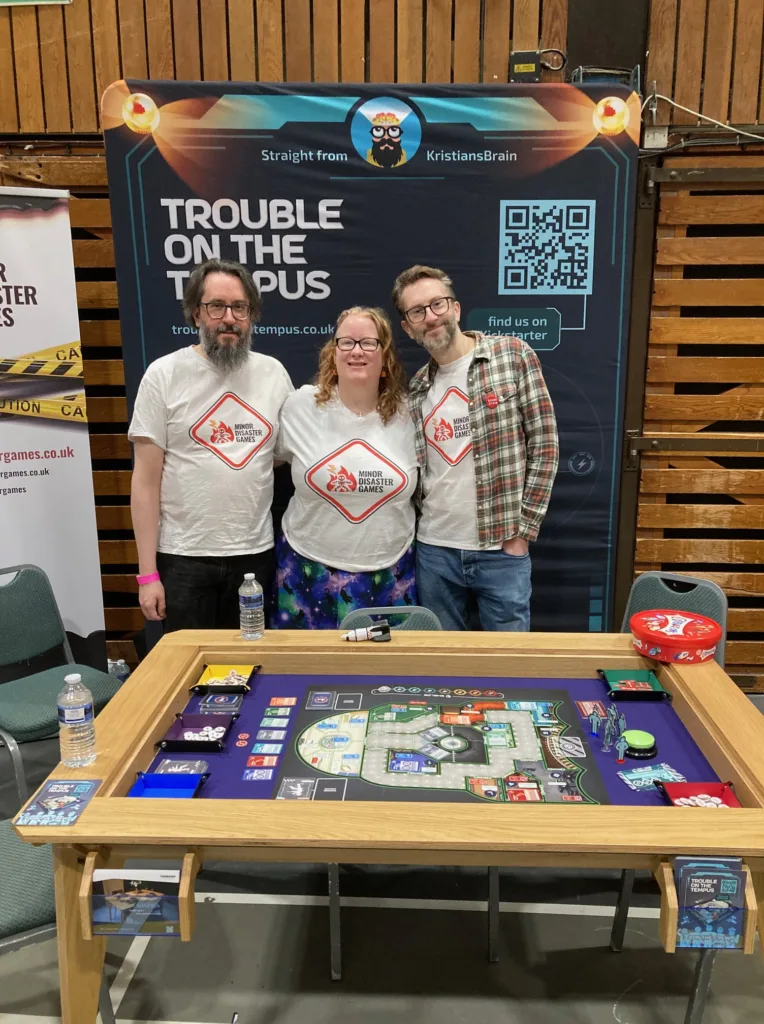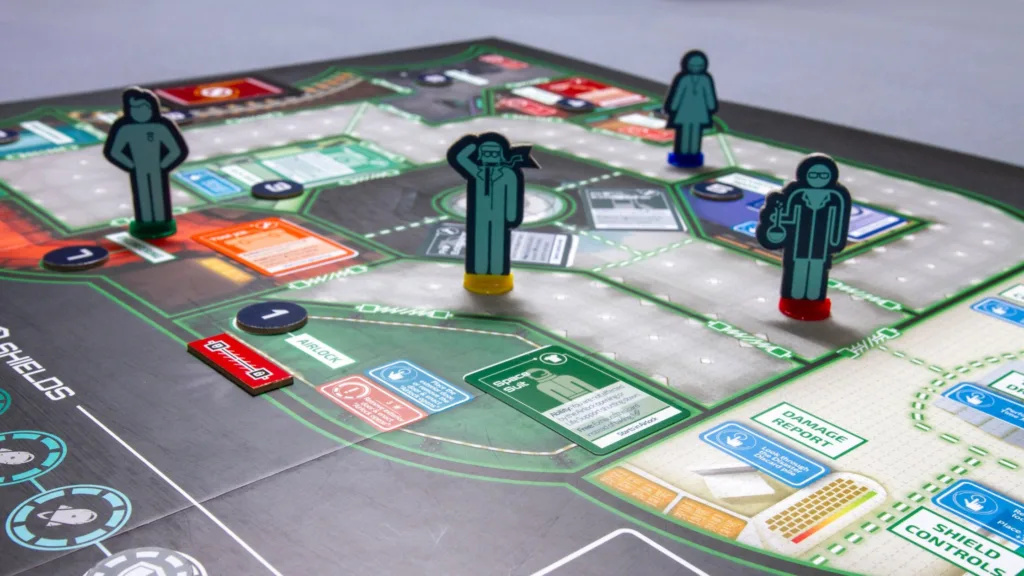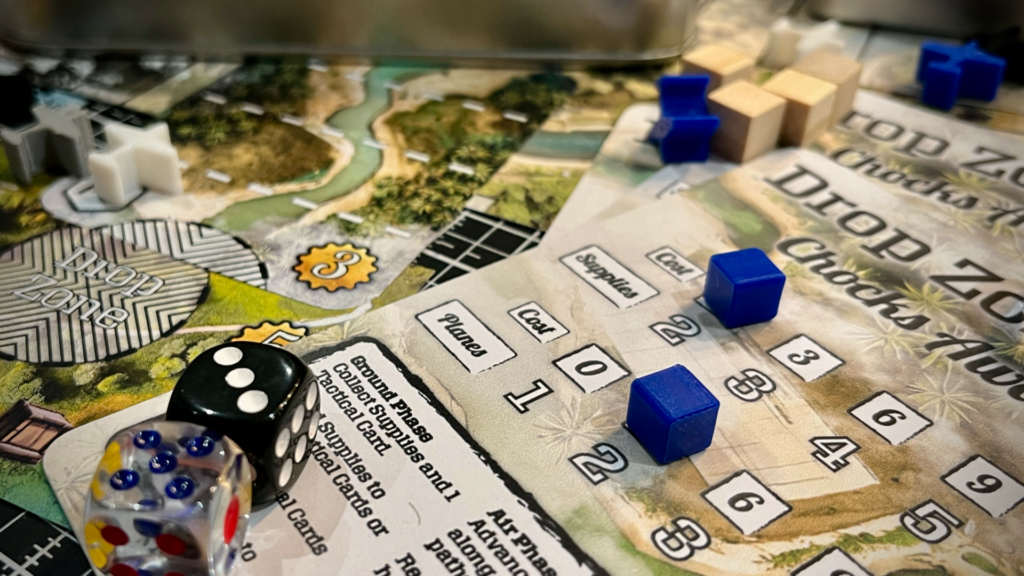Meet Minor Disaster Games, a family team of creators whose journey from game players to game designers shows how passion can overcome fear. Their upcoming time-bending game “Trouble on the Tempus” offers players the rare chance to loop back and try again when disaster strikes—a mechanic born from countless evenings mastering Pandemic. Through candid conversation, Caley, Kristian, and Liam reveal not just their creative process, but also the very human anxieties that come with putting your creation into the world. Their story reminds us that game design isn’t just about mechanics and artwork, but about finding joy in the journey while managing the inevitable fear that comes with creating something new.
Enjoy.
Joe: Welcome to the What If blog! Can you start with a short introduction, who are you and what brings you to the world of board game design?
Minor Disaster Games: Hi, we are Minor Disaster Games. We are made up of married couple Caley Powell-Mitchell-Dolby and Kristian Mitchell-Dolby, and Kristian’s brother Liam Mitchell-Dolby. About ten years ago Kristian had an idea for a board game and turned to his brother Liam who’s a graphic designer, to create the designs for the game, which became Trouble On The Tempus. Caley came on board later to help with marketing and social media and we became an official company last year. We are now getting ready to launch our game on Kickstarter in May this year.
Joe: Great to meet you all! Sounds like quite the crew, maybe you’d fare well on the Tempus?! How about you tell us a little about your game: where did the idea come from and what’s it all about?
Minor Disaster Games (Kristian): In the game players are the crew of the Tempus, a deep space time travelling vessel, as their first mission has gone wrong and the ship is falling apart around them. They can engage the ship’s time drive to create a time loop where they can return to the beginning of the game any time the disasters get too much and try again with the added knowledge and equipment they have picked up on previous runs but each time they do they create a Paradox in space and time and there is only so many times you can do that before they blink out of existence.

The idea came from my old gaming group playing Pandemic so much we became experts, we could beat it on any difficulty, and that led into other cooperative games we’d play and got me thinking about the moment in those games where you realise you are about to lose but can also see where you went wrong on previous turns. I wondered if I could come up with a game that took those moments and gave the players a chance to try again to see if better decisions would have saved them, so the time travel theme was where I started from, and I slowly added mechanics that facilitated that element without overcomplicating it, because I knew the strength would be the push your luck memory aspect. In terms of us faring well on the Tempus, when designing the characters I named one of our characters after Caley so she technically is one of the Tempus crew.
Joe: I love time travel as a theme, and that do over mechanic is a lovely idea. What challenges have you found when implementing it as a mechanic in your game? And how have you gone about honing the idea, did it start out much differently to how it is now?
Minor Disaster Games: (Kristian) The core mechanic hasn’t changed much over the years to be honest, the resetting of the deck is very Pandemic but with the point being for it to be more predictable. Most of the work has been in trying to balance the game to get the difficulty to a point where it was winnable but the time jumps were necessary. Unlike Pandemic, the deck resetting isn’t a punishment, it’s a boon, so it’s sort of a mimic of the mechanic whilst being a reversal of the intent. We definitely want it to be a game that people lose more than win but making sure that it is still fun is the hard part, players have to feel like progress has been made and they’d do better next time, otherwise they won’t play again.

We had to play through hundreds of scenarios to identify unwinnable combinations and effects that overpowered the players, that was the hard part. I still can’t say for sure that sometimes the cards won’t simply fall in a manner that is super easy or impossibly hard, but I think that’s inevitable, so you just have to try and minimise that possibility in the design.
Joe: It sounds intriguing and I can’t wait to give it a shot. A few months back you posted on Instagram (I think) about feeling ‘the fear’, it was an interesting thought, and I think something that resonates with me. Do you think you could outline what you meant by it?
Caley: When we set up our social media we decided to post every Tuesday with a statement or a question, that we called #Truesday, which is just an opportunity for us to put something out there that we wanted to talk about and ask for advice (this is before we learnt about the amazing Board Game Protohype community). One of our Truesday posts was about fear as we were in a scary time in the development of the game, we were in the last month of 2023, about to go into our first full year as a company and our plan for 2024 was to finalise the design of our game after it going through changes after playtesting, finish the box art, go to loads of board games conventions, send our game out to reviewers and launch our Kickstarter, all of which sounded really daunting.
We are a board game company but we are also human, we feel fear, have anxiety, have imposter syndrome and I really wanted to share that publicly.
We are a board game company but we are also human, we feel fear, have anxiety, have imposter syndrome and I really wanted to share that publicly to start a conversation around fear and how we overcome our fear because putting our games out there and ourselves out there as creators is a scary thing to do.

I posted an image with the post which was of Susan Jeffers book ‘Feel The Fear and Do It Anyway’ as reading this really changed my relationship with fear. Knowing that the fear shouldn’t stop you from doing the task and that you need to approach each task you are fearful of with the mindset that you will handle whatever the outcome is.
I’m scared of people playing our game, I’m scared of people not wanting to play our game, I’m scared of us failing our Kickstarter, I’m scared of us succeeding our Kickstarter but I’m still going to take our game to conventions, still going to send it to reviewers and still going to launch it on Kickstarter and whatever the response; we will handle it together.
I don’t think I’m alone in feeling these fears so I wanted to write the post to communicate with other designers to feel less alone and learn how they overcome fear. You commented on the post about listening to an episode of The Blind Boy podcast, which episode was it and how else do you help overcome fear?
Joe: Thanks Caley, especially for your honesty here. It’s an important topic, and I think you’re right that many of these fears will be felt across many people designing board games and right across the creative industries. Blindboy talks about it often in his podcast; particularly describing how that fear holds us back so much from accomplishing the things we might be able to if we weren’t so scared.
My key takeaway has been that I need to find more ways of letting go of the fear, and start to become braver at sharing what I’m working on. I’m sharing plenty on social media, but there’s very little scope for any critique or anything other than positivity and intrigue about my projects on there. But in the real world, that’s different, or at least it feels different.
It looks like Susan Jeffers book has helped you to push through some of the fear – do you think you can explore why/how it’s changed your feelings?
Caley: There are things in Susan Jeffers book that changed my way of thinking, the first thing was actually the title, it says feel the fear and do it anyway and the book doesn’t tell you to ignore the fear, you can feel it, it is a valid thing to feel because life can be scary but I loved that the book has activities and exercises that you can do that made me put things in perspective and give me mantras to live by, such as ‘the only way to get rid of the fear of doing something is to go out and do it’ and ‘pushing through fear is less frightening than living with the underlying fear that comes from a feeling of helplessness’ and ‘not only am I going to experience fear whenever I’m on unfamiliar territory but so is everyone else’. I think sometimes seeing those sentences in black and white and reading stories of other people’s experiences with fear made me realise that I am not alone, everyone is fighting fear in some ways in their life and you have to make a choice of whether you want to be brave and tackle the fear or just stay in the unpleasant feeling of fear and helplessness.
I don’t know about you but I spend a lot of time thinking ‘what if’ and catastrophising and realise that half the things my Chatterbox, which is what Susan calls the negative part of your brain in the book, is way worse than what actually happens but you don’t know that until you actually tackle the fear, put your game out there, ask people to play it, give it to reviewers. I mean, if I am being honest I do occasionally just wallow in that unpleasant feeling, letting my Chatterbox fill me with negative thoughts and energy but I know that I can pull myself out of these moments, I start to strive for that great feeling you get when you overcome your fears and the curiosity that I have for wanting to know what will happen if I do the thing that scares me. In the book she talks about how we are all in control of the choices we make, we can choose to go from pain to power and I think it’s great to remember that and know that you are not alone in how you feel.
I remember late one night whilst I was sitting at my computer working my wife came up to me and said ‘remember this is supposed to be fun’, and that really made me change my attitude.
Joe: This sounds like a refreshing way to start looking at the more challenging bits of what we do. So with this guidance in mind how has your approach to game design and being a game designer changed?
Liam: I think one of my key things is to be sure to have fun with it. Designing and developing a game is a lot of hard work but the spark that started all of this was a fun idea we wanted to share. It’s so important to hold on to that otherwise the joy of the project vanishes. As we’ve been ramping up to our launch date there’s been a lot of deadlines to meet and pressures mounting and it can feel overwhelming at times. It’s been a lot of late nights, finalising artwork, organising meetings, writing content etc and there were times it felt like it was getting on top of all of us. I remember late one night whilst I was sitting at my computer working my wife came up to me and said “remember this is supposed to be fun”, and that really made me change my attitude. It encouraged me to find joy in every stage of the journey.
Rather than being fearful or overwhelmed by new challenges instead find the fun in it. Never illustrated box art for a game before? Okay, you’ve always wanted to so that’s fun you get to. Need some animation to demo your game? Okay, you like learning design software so it’s fun to get started! Need to set up and run Meta Ads? Okay, that’s less fun but it’s still an intriguing new puzzle to solve. It doesn’t mean it’s not scary and you don’t have self-doubt, but it certainly stops you focusing on the scary side of it all. If you’re having fun that attitude is infectious and spreads into whatever you’re creating. We want our players/customers/audience to have a good time, and our attitude when creating is a big factor in that. Always remember this is supposed to be fun!
Joe: That’s an important piece of advice and something that’s so easy to forget. Do you think it helps that you’re working as a team on this? Or does that bring even more insecurities into the mix?
Liam: Being a team has been hugely helpful. It’s safe to say if we didn’t have each of us involved we wouldn’t be as far into this as we are now. We’ve been able to share responsibilities and play to each other’s skills. Bouncing off each other has also kept us accountable. However, that brings a whole other side of insecurity where you worry you’re letting the other two down and second guessing if you’re doing your share. Ultimately it comes down to trust and honesty and I think we have a good dynamic.
Joe: Thanks team, and thanks for your insight this week. Before you leave, can you let us know how we can support Minor Disaster and your upcoming game Trouble on the Tempus?
Minor Disaster: Thanks Joe. We are going to be launching Trouble on the Tempus on Kickstarter on Tuesday 27th May. just before we go to the UK Games Expo so if people want to be notified on when we launch, click here.
You can also find us on Instagram at @minordisastergames and sign up to our mailing list at https://troubleonthetempus.co.uk/
Thanks for joining us on this deep dive into the creative process behind Trouble on the Tempus! To follow Minor Disaster Games’ journey and support their upcoming Kickstarter campaign launching this May, follow them on social media and sign up for their newsletter. Want more candid conversations with game designers? Subscribe to our blog for weekly insights, design stories, and exclusive interviews with the creative minds shaping the tabletop gaming world. Your next favorite game might just be waiting in our next post!



